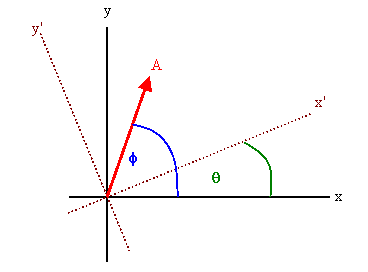

Assume {|ui>} and {|ti>} are orthonormal bases
and the operator U changes one basis into the other, i.e. U|ui>
= |ti>
for all basis vectors. Then the operator U is a unitary operator.
Proof:
For every basis vector
<ui|U† = <ti|, U†U|ui>
= U†|ti> = ∑j|uj><uj|U†|ti>
= ∑j|uj><tj|ti> = |ui>
--> U†U = I.
Similarly,
UU†|ui> = U∑j|uj><uj|U†|ui>
= ∑jU|uj><tj|ui> = ∑j|tj><tj|ui>
= |ui>
==> UU† = I.
Every unitary transformation transforms one basis into another.
Proof:
Assume that U is unitary and that {|ui>} is a basis and that U|ui>
= |ti>.
Then
<ti|tj> = <ui|U†U|uj>
= <ui|uj> = δij.
The vectors {|ti>} are orthonormal.
Are they
a basis?
We have to show that every |ψ> can be
expanded in terms of the {|ti>}. Let |ψ>
be an arbitrary vector in a vector space E.
U†|ψ> ∉ E, therefore U†|ψ> = ∑idi|ui>.
It follows that UU†|ψ> = ∑idiU|ui>
= ∑idi|ti>.
or |ψ> = ∑idi|ti>.
Therefore {|ti>}
is a basis.
Changing a basis is therefore called a unitary
transformation.
A unitary transformation is equivalent to a change of basis.
Let U be the unitary transformation transforming {|ui>}
into {|ti>}. The matrix elements of U in the first basis are <ui|U|uj>
= <ui|tj> = Uij.
|ψ> = ∑jdj|tj> = ∑j<tj|ψ>|tj>
and |ψ> = ∑jaj|uj> = ∑j<uj|ψ>|uj>.
We find the components of a vector |ψ> in the second
basis in terms of the components in the first basis using
<ti|ψ> = ∑j<ti|uj><uj|ψ>
= ∑jUji*<uj|ψ> = ∑jU†ij<uj|ψ>.
We have
di = <ti|ψ> = ∑jU†ij<uj|ψ>
= ∑jU†ijaj.
Similarly, ai = ∑jUijdj.
Example:

 .
. .
. 
Let Ω be the projector onto the x axis in the {|xi>}
basis. The matrix of Ω in the {|xi>}
basis is
Ωij =  ,
and we have
,
and we have
 .
.
The matrix of Ω in the {|xi’>}
basis is
 ,
,
and we have

exactly the same as in the {|xi>} basis.
The operator Ω does something different to the {|xi’>} basis vectors then to the {|xi>} basis vectors. Let Ω’ be the operator that does to the new basis vectors what Ω does to the old basis vectors.
Example:The matrix elements of Ω’ in the {|xi’>}
basis are the same as the matrix elements of Ω in the {|xi>}
basis.
Ω’i’j’ = Ωij.
But
Ω’i’j’ = (U†Ω’U)ij and therefore
Ωij = (U†Ω’U)ij or (UΩU†)ij
= Ω'ij.
We distinguish between active and passive
unitary transformations.
Active: Change all vectors |ψ> to U†|ψ>.
Passive: Change the basis from {|ui>}
to {U|ui>}.
Active: The operator Ω still does the same thing to
all basis vectors. But if |Φ> = Ω|ψ> then |Φ’> ≠ Ω|ψ’>.
We have |Φ’> = U†|Φ> = U†Ω|ψ> = U†ΩU|ψ’>.
In our example the rotated vector has a different
projection onto the x axis.
Passive: The operator Ω changes into Ω’,
which does the same thing to the new basis vectors as Ω does to the old basis vectors.
Ω’ = UΩU†. In our example the projector onto the x
axis becomes the projector onto the x’ axis.
 .
. .
. .
.We will soon show that the operator describing the evolution of a physical system is a
unitary operator. Therefore the evolution is a unitary transformation.
There are two ways of looking at a unitary transformation. The Schroedinger picture of quantum mechanics treats it as an
active transformation. The state vector changes with time, the operator does not change
unless it contains time explicitly. The wave function evolves in time.
The Schroedinger
equation describes this evolution in a particular representation.
The Heisenberg picture of quantum
mechanics treats the unitary transformation as a passive transformation. The state vector
is fixed, the operators change with time. Both approaches yield the same predictions.